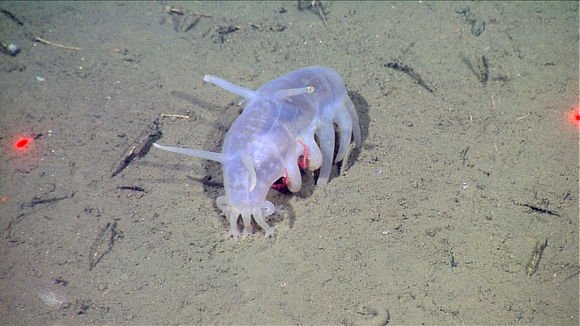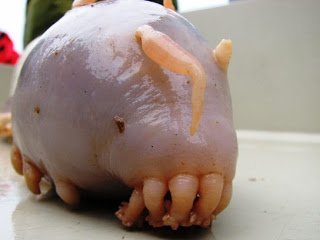Greetings steemians, hope you all have a great week! Continuing my strange animals series, I want to present you today with a group of deep-sea, alien-like animals that I find to be quite cute..in a bizarre way! The creatures I am talking about are in fact a type of sea cucumber commonly known as...
Sea Pigs
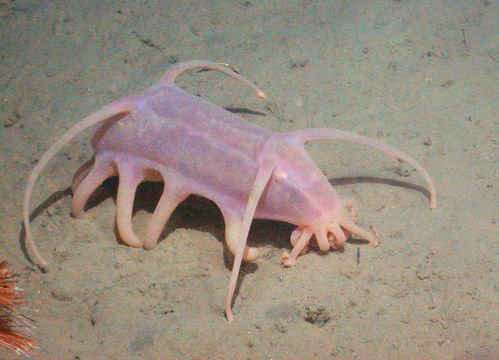
Scotoplanes globosa (Credit)
Sea pigs are members of the genus Scotoplanes and can be found lurking deep in the ocean floors, specifically on the abyssal plain in the Atlantic, Pacific and Indian Ocean, at depths ranging from 1200 to 6000 meters.
Although they don't look much like them, they are actually sea cucumbers (Holothuroidea). What makes them stand out though is that they are the only representatives of the group capable of legged locomotion! [1]
These weird looking creatures have a fat, plumb-like body, that is 2-4 in. (5 to 10 cm) long. Their mouth is surrounded by ten feeding tentacles and depending on the species, they have five to seven pairs of feet that are used for walking on the ocean floor. On their upper side, they have three pairs of papillae, two sets are long and whip-like and the third is short and inconspicuous.
Here's a beautiful video showing the creature in action:
Now, let's learn more about these unique creatures!
Why are they called sea-pigs?
Supposedly, their legs and their fat, plump-like appearance have won them their common name "sea pigs" [2]. Other than the pink color, I don't see much of a resemblance... but whatever...
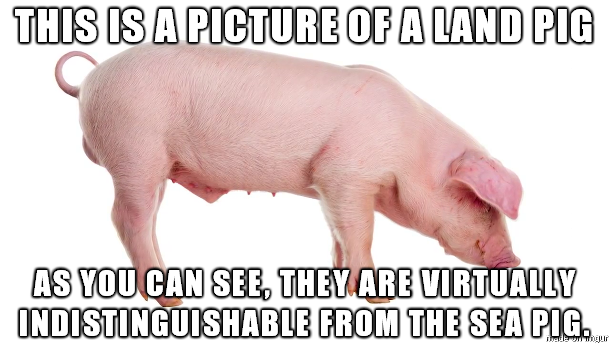
How Many Species of Sea Pigs Are Out There?
As of August 2017, scientists have described 5 scotoplanes species:
- Scotoplanes clarki
- Scotoplanes globosa
- Scotoplanes hanseni
- Scotoplanes kurilensis
- Scotoplanes theeli
With our oceans mostly unexplored, chances are that there are many other scotoplanes that have yet to be discovered!
How do they spend their day?
Unfortunately, we don't know much about their behavioral patterns, like how they mate, because their deep sea environment makes studying them practically impossible. Well, it's not like there's much to do in the deep dark waters they inhabit!
What we do know is that like many other sea cucumbers, they often occur in large herds, sometimes numbering in the hundreds or thousands. However, these aggregations are probably not because they are social animals, they just gather to places where there is abundacy of food!
And speaking of food...
What do they eat?
Sea pigs are deposit animals, feeding on decaying plant and animal material that falls on the ocean floor. Their mouths are surrounded by a ring of feeding tentacles that they use to filter the mud and from the actual food. They appear to have a preference for "fresh" food that has recently fallen from the ocean’s surface, e.g. a whale's corpse. Mmmmmm.....delicious!
Do they have any enemies and are they threatened?
Sea pigs live in the deepest abyssal parts of the world’s oceans and as a result we assume that they don't have any natural predators. However, research has shown that they fall victim to numerous parasitic invertebrates, including gastropods (snails) and small tanaid crustaceans. These parasites usually dig their way into the bodies and suck on their juices! That sounds horrible! [4]
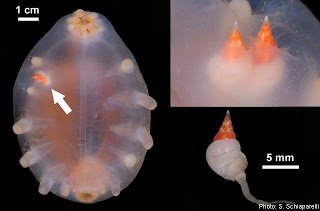
Sea pig parasitized by a sea snail (credit)
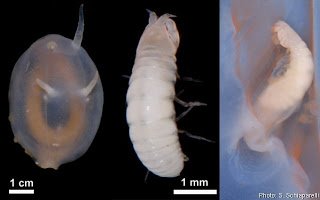
Sea pig parasitized by a tiny crustacean
Like with so many other animals, humans are their biggest threat, with deep-sea trawling being responsible for thousands of deaths each year. To give you an idea, a single sweep from a trawler can easily kill up 300 Scotoplanes as a bycatch..
Their conservation status has not been officially assessed so we can't be sure if the species is under any serious threat. However, the large number of individuals caught each year by trawlers indicates that the populations are still large and healthy.
This is it for today, see you in tomorrows strange animal post. Stay tuned!:)
References & Further Reading
- Photographic evidence of a unique type of walking in deep-sea holothurians
- Eol.org: Scotoplanes
- Eol.org: Scotoplanes globosa
- Echidnoblog:THE SEA PIG!!
- Feeding selectivity and rapid particle processing by deep-sea megafaunal deposit feeders: A 234Th tracer approach
SteemSTEM & Steemiteducation
Please consider supporting the @steemstem project. SteemSTEM is a community driven project which seeks to promote well written & informative Science Technology Engineering and Mathematics postings on Steemit. Click here to join the chat and learn more! The steemstem project is run by @justtryme90, @lemouth and some other cool guys & gals :)You may also want to check, @steemiteducation, a project for steemian educators and people posting educative content
More Strange Animals To Come
I will be posting one new strange animal each and every day so if you enjoyed this post make sure to follow me and let's discover together some of the world's most strange and bizarre creatures! An upvote and resteem would be nice too :P In the meantime, you may want to check out some other weird animals I have posted about, like the Giraffe-necked Weevil, the pokemon-like Mexican Mole Lizard and Ampulex compressa, the wasp that enslaves cockroaches with a sting to the brain!


